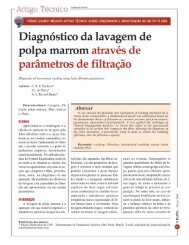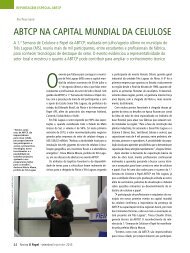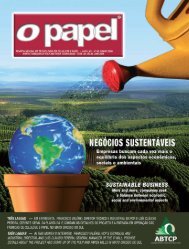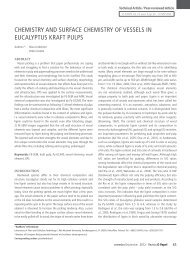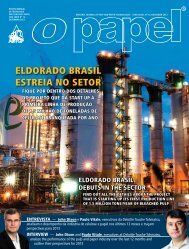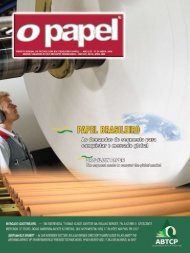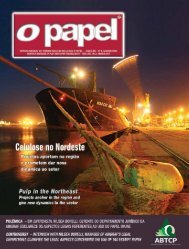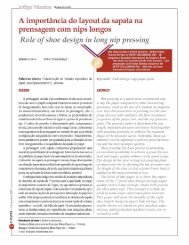Bracelpa Columngrasp this figure, 1.3 billion tons is equivalent to more than half of all ofBrazil’s emissions in 2005 3 . The pulp and paper sector alone contributedwith an average stock of approximately 440 million tons of tCO 2e.These estimates do not include, conservatively, stock inconservation areas maintained by the sector, which representsapproximately 2.9 million hectares. When we consider the potentialuse of planted lumber instead of gas or fossil fuels in many chains ofproduction, the potential for further climate benefits is even greater.However, although Brazil has favorable soil and climate(edaphoclimatic) conditions and despite having the most advancedtechnology, Brazil still faces a substantial planted-forest deficitand underused potential on account of a number of barriers. Inorder to overcome this challenge, it is crucial to promote and placeeconomic value on climate, social and environmental benefitsthrough the numerous public and private instruments available,including carbon markets.Given such, the Brazilian pulp and paper sector, in conjunctionwith a number of non-governmental organizations, is developingthe Brazil Sustainable Forests Initiative. This initiative is based onstructuring and implementing a strategic program to expand andsustainably manage industrial forests in a way that integrates theprotection and conservation of native forests, as an alternativeto mitigating climate change and to promote sustainable landdevelopment. The project is inspired by the most rigorousmethodologies, including the Clean Development Mechanism (CDM)addressed in the Kyoto Protocol, which will serve as a basis forlarge-scale pilot programs, as well as for more widespread sectorpolicies and programs.Thus, the sector expects to coordinate efforts to value climate, socialand environmental benefits, including through carbon credits, withthe need to and challenge of expanding Brazilian forests within thecontext of the green economy. This is an opportunity to catalyze deepand positive changes in the economy and the communities involved inthe forestry business. In order to make this a reality, we must improveinteraction and involvement with multilateral principles and norms.However, this is not only about Brazilian potentials or needs.According to the UN Food and Agriculture Organization (FAO)forecasts, more than two million people worldwide depend on forestbiomass to survive, which makes the need to step up efforts and pursueinternational cooperation in this area ever more clear. Brazil is poisedto act as a leader, including cooperation from South-South, since it hasvast experience that can be shared with other developing countries inan attempt to encourage green economies based on synergies betweenmitigating climate change and promoting sustainable development.Starting with the United Nations Framework Convention onClimate Change (UNFCCC) accorded in Rio in 1992, the internationalcommunity has made important advances in combatingglobal warming and, more indirectly, in promoting sustainabledevelopment. The Convention and its Kyoto Protocol were alsosuccessful in initiating one of the main mitigation instruments, inother words, valuing carbon through market mechanisms, capableof helping bring the factor of a variable climate into the productionand consumption systems. Forests were taken into considerationfor these mechanisms, though less extensively, in a limited mannerand subject to the restrictions of developed countries. We need toadvance their involvement more ambitiously.It is important to include mechanisms that value forest carbonsince they can contribute to the development of other topics thatare important for sustainable development. Of all externalitiesreferenced in the green-economy agenda, “climate” externality iscertainly the one with the greatest potential for internalizing in theproduction and consumption systems since it can be consistentlymeasured, can be directly attributed to consumers, companies andchains of production and its costs can be estimated and comparedon a global level.Therefore, in the context of the forestry based economy, it isalso important that monetary valuing of carbon serves not onlyas an instrument for mitigation but also a lever for sustainabledevelopment. Other green-economy topics (such as waterresources, land use, renewable energy, social inclusion in ruralareas, biodiversity and the fight against deforestation) can beassociated with the value of carbon based on improving andexpanding current mechanisms, always using high environmentalintegration standards.Due to the interdisciplinary nature and because it involvessynergies between the international climate-change regime andthe other topics of the green economy, it is fundamental that thesepoints be addressed in the discussions and in the adoption ofprinciples and criteria at the Rio+20.This is a two-way street that needs to be further explored. Valuingforest carbon, including by means of carbon markets, can lead todevelopments in other areas as well as synergies with other topics thatcan make mitigation efforts in production and consumption systemsmore effective, promoting the green economy in an integrated fashion.This approach seems essential to guarantee the counterparties andcreate the means to value and make the necessary expansion of thegreen economy feasible in Brazil and other developing countries in asustainable and integrated manner.•3According to Brazil’s Second Communiqué to the United Nations Framework Convention on Climate Change (UNFCCC), national emissions in 2005 totaled approximately2.18 billion tons of CO 2.56 <strong>Revista</strong> O <strong>Papel</strong> - abril/April 2012
Economic Sector ArticleBY Ricardo Jacomassi,Chief Economist at Hegemony Projeções Econômicas: ricardo.jacomassi@hegemony.com.brsérgio britoSoundness of Brazil’sfinancial systemMore than a decade ago, it would be impossibleto imagine that the two most importantfinancial institutions worldwide would reportsomething positive about Brazil’s finances. Being a rareexception among countries, the mission coordinated bythe IMF (International Monetary Fund) and the WorldBank in March highlighted Brazil’s sound financialsystem. And the compliments were many.The Financial Sector Assessment Program 1led by the two institutions was implemented in 1999and consists of an in-depth analysis of the financialsector of developing and industrialized countries.The two main objectives are: analyze the financialstability and development dynamics of financialsystems. Together they can offer information aboutthe financial relationships between economies.In one of the most important parts of the report, the IMFand World Bank mission declared:“The FSAP 2 mission concluded that Brazil’s financialsystem is stable, with a low systemic risk level andconsiderable protection margins. High capital margins,coupled with high levels of international reserves and aflexible exchange rate, have helped the economy absorbrecent external shocks. With regards to challengescreated by the inflow of volatile capital and the rapidexpansion of credit, Brazilian authorities have been ableto effectively apply macroprudential measures to containsystemic risks”.This is a major achievement for the country,particularly in view of the exposed fractures onthe part of financial systems of countries like theUnited States and others in the Euro region. EvenChina’s financial system is presenting unsustainableconditions in the long term, such as, for example, theexcess credit directed at state-owned companies.However, before throwing all the merits received inMarch 2012 on the table, it is important to inform thatthis achievement took more than a decade, followingimplementation of the Real Plan and reformulationof the Financial System, both during the FernandoHenrique Cardoso administration.Putting all positive points aside, the missioncoordinated by the two entities highlighted two mattersthat could prevent the development of capital markets:(i) high interest rates; (ii) and the majority of financialinstruments being short-term.To limit these points for financial institutionsit is necessary “that inflation continue droppingand internal savings (public and private) continueincreasing. Additionally, certain reforms in the financialsector could encourage this process, especially bystrengthening the role of institutional investors.As interest rates continue to drop, stimulating thedemand of investment funds for longer-term securities,well articulated measures will also be necessary toincrease the offer of corporate securities, in order totake advantage of this increase in demand”.Everyone knows that a balanced financial systemis an essential condition for economic growth and itslong-term equilibrium, however, it is necessary that notonly the Financial System present such conditions.The productive system, that is, the industrial sector,needs to achieve the same level of sustainability andcompetitiveness. Just like the reformulations thatwere made to strengthen the Financial System, we didthe same effort in the Productive Sector.Maintaining current conditions, industry will notsupport its production bases for a very long time, asit is more advantageous to import than to produce.Production does not need protectionism, alwaysassociated to the right-now short-term vision. Asa producer of wealth and a source of added-value,industry needs reformulations that ensure the sameconditions of competition that its peers have today.Let’s see what happens!•1. < http://www.imf.org/external/lang/portuguese/np/sec/pr/2012/pr1297p.pdf >2. FSAP: Financial Sector Assessment Programabril/April 2012 - <strong>Revista</strong> O <strong>Papel</strong>57



